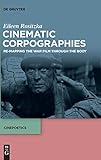Cinematic Corpographies : Re-Mapping the War Film Through the Body / Eileen Rositzka.
Material type: TextSeries: Cinepoetics – English edition ; 3Publisher: Berlin ; Boston : De Gruyter, [2018]Copyright date: ©2018Description: 1 online resource (VIII, 202 p.)Content type:
TextSeries: Cinepoetics – English edition ; 3Publisher: Berlin ; Boston : De Gruyter, [2018]Copyright date: ©2018Description: 1 online resource (VIII, 202 p.)Content type: - 9783110579635
- 9783110579710
- 9783110580808
- 791.43/6581 23
- PN1995.9.W3 R675 2018
- online - DeGruyter
- Issued also in print.
| Item type | Current library | Call number | URL | Status | Notes | Barcode | |
|---|---|---|---|---|---|---|---|
 eBook
eBook
|
Biblioteca "Angelicum" Pont. Univ. S.Tommaso d'Aquino Nuvola online | online - DeGruyter (Browse shelf(Opens below)) | Online access | Not for loan (Accesso limitato) | Accesso per gli utenti autorizzati / Access for authorized users | (dgr)9783110580808 |
Diss. St. Andrews 2017.
Frontmatter -- Acknowledgments -- Contents -- 1. Introduction -- 2. Measuring the Trenches: Corpographies of the First World War -- 3. From Above and From Within: Aerial Views and Corpographic Transformations in the WWII Combat Film -- 4. Dismembering War: Touch and Fragmentation in Anthony Mann’s Men in War -- 5. Uncharting Territories: The Vietnam War’s Shattering of the Senses -- 6. Zero Dark Thirty: Corpographies of the War on Terror -- 7. Conclusion -- Bibliography -- Filmography -- Subject index -- Name index -- Film index
restricted access online access with authorization star
http://purl.org/coar/access_right/c_16ec
Writing on the relationship between war and cinema has largely been dominated by an emphasis on optics and weaponised vision. However, as this analysis of the Hollywood war film will show, a wider sensory field is powerfully evoked in this genre. Contouring war cinema as representing a somatic experience of space, the study applies a term recently developed by Derek Gregory within the theoretical framework of Critical Geography. What he calls “corpography” implies a constant re-mapping of landscape through the soldier’s body. These assumptions can be used as a connection between already established theories of cartographic film narration and ideas of (neo)phenomenological film experience, as they also entail the involvement of the spectator’s body in sensuously grasping what is staged as a mediated experience of war. While cinematic codes of war have long been oriented almost exclusively to the visual, the notion of corpography can help to reframe the concept of film genre in terms of expressive movement patterns and genre memory, avoiding reverting to the usual taxonomies of generic texts.
Issued also in print.
Mode of access: Internet via World Wide Web.
In English.
Description based on online resource; title from PDF title page (publisher's Web site, viewed 25. Jun 2024)


